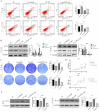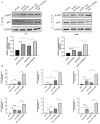Helicobacter pylori upregulates circPGD and promotes development of gastric cancer
- PMID: 38407616
- PMCID: PMC10896836
- DOI: 10.1007/s00432-023-05537-w
Helicobacter pylori upregulates circPGD and promotes development of gastric cancer
Abstract
Purpose: Helicobacter pylori (H. pylori) has unique biochemical traits and pathogenic mechanisms, which make it a substantial cause of gastrointestinal cancers. Circular RNAs (circRNAs) have concurrently been identified as an important participating factor in the pathophysiology of several different cancers. However, the underlying processes and putative interactions between H. pylori and circRNAs have received very little attention. To address this issue, we explored the interaction between H. pylori and circRNAs to investigate how they might jointly contribute to the occurrence and development of gastric cancer.
Methods: Changes in circPGD expression in H. pylori were detected using qRT-PCR. Cell proliferation and migration changes were assayed by colony formation, the CCK-8 assay and the transwell assay. Apoptosis was measured by flow cytometry. Western blot was conducted to detect changes in cell migration, apoptosis, proliferation and inflammation-associated proteins. QRT-PCR was used to measure changes in circPGD and inflammation-associated factors.
Results: We found that H. pylori induced increased circPGD expression in infected human cells and facilitated gastric cancer progression in three ways by promoting cell proliferation and migration, enhancing the inflammatory response, and inhibiting apoptosis.
Conclusions: CircPGD appears to play a role in H. pylori-related gastric cancer and may thus be a viable, novel target for therapeutic intervention.
Keywords: Apoptosis; Gastric cancer; Helicobacter pylori; Inflammation; circRNAs.
© 2024. The Author(s).
Conflict of interest statement
The authors declare no competing interests.
Figures







Similar articles
-
CircRNA_15430 reduced by Helicobacter pylori infection and suppressed gastric cancer progression via miR-382-5p/ZCCHC14 axis.Biol Direct. 2023 Aug 25;18(1):51. doi: 10.1186/s13062-023-00402-9. Biol Direct. 2023. PMID: 37626393 Free PMC article.
-
Circular RNA circPGD contributes to gastric cancer progression via the sponging miR-16-5p/ABL2 axis and encodes a novel PGD-219aa protein.Cell Death Discov. 2022 Sep 14;8(1):384. doi: 10.1038/s41420-022-01177-0. Cell Death Discov. 2022. PMID: 36104322 Free PMC article.
-
CircMAN1A2 is upregulated by Helicobacter pylori and promotes development of gastric cancer.Cell Death Dis. 2022 Apr 28;13(4):409. doi: 10.1038/s41419-022-04811-y. Cell Death Dis. 2022. PMID: 35484118 Free PMC article.
-
Apoptosis in gastric epithelium induced by Helicobacter pylori infection: implications in gastric carcinogenesis.Am J Gastroenterol. 2001 Jan;96(1):16-26. doi: 10.1111/j.1572-0241.2001.03447.x. Am J Gastroenterol. 2001. PMID: 11197247 Review.
-
Review article: the role of inflammation in the pathogenesis of gastric cancer.Aliment Pharmacol Ther. 1999 Mar;13 Suppl 1:13-8. doi: 10.1046/j.1365-2036.1999.00003.x. Aliment Pharmacol Ther. 1999. PMID: 10209682 Review.
Cited by
-
Bacteria and Carcinogenesis and the Management of Cancer: A Narrative Review.Pathogens. 2025 May 21;14(5):509. doi: 10.3390/pathogens14050509. Pathogens. 2025. PMID: 40430828 Free PMC article. Review.
-
Metformin Inhibits the Development of Helicobacter pylori-Associated Gastritis by Regulating the ERK-MMP10-IL-1β Axis.Cell Biochem Biophys. 2025 Sep;83(3):3597-3606. doi: 10.1007/s12013-025-01739-w. Epub 2025 Apr 4. Cell Biochem Biophys. 2025. PMID: 40180700
-
Infection of Helicobacter pylori contributes to the progression of gastric cancer through ferroptosis.Cell Death Discov. 2024 Dec 2;10(1):485. doi: 10.1038/s41420-024-02253-3. Cell Death Discov. 2024. PMID: 39622791 Free PMC article. Review.
-
Circular RNAs in cancer.MedComm (2020). 2025 Feb 2;6(2):e70079. doi: 10.1002/mco2.70079. eCollection 2025 Feb. MedComm (2020). 2025. PMID: 39901896 Free PMC article. Review.
-
Helicobacter pylori Infection in Patients with Gastric Cancer: A 2024 Update.Cancers (Basel). 2024 May 22;16(11):1958. doi: 10.3390/cancers16111958. Cancers (Basel). 2024. PMID: 38893079 Free PMC article. Review.
References
-
- Domínguez-Martínez DA, Fontes-Lemus JI, García-Regalado A, Juárez-Flores Á, Fuentes-Pananá EM (2023) IL-8 secreted by gastric epithelial cells infected with Helicobacter pylori CagA positive strains is a chemoattractant for Epstein–Barr virus infected B lymphocytes. Viruses 15(3):651. 10.3390/v15030651 - PMC - PubMed
-
- Ghafouri-Fard S, Khoshbakht T, Bahranian A, Taheri M, Hallajnejad M (2021) CircMTO1: a circular RNA with roles in the carcinogenesis. Biomed Pharmacother 142:112025. 10.1016/j.biopha.2021.112025. (Epub 2021 Aug 12) - PubMed
-
- Lee YC, Chiang TH, Chou CK, Tu YK, Liao WC, Wu MS, Graham DY (2016) Association between Helicobacter pylori eradication and gastric cancer incidence: a systematic review and meta-analysis. Gastroenterology 150(5):1113-1124.e5. 10.1053/j.gastro.2016.01.028. (Epub 2016 Feb 2) - PubMed
MeSH terms
Substances
Grants and funding
- Grant No. 81772157/National Natural Science Foundation of China
- Grant No. 81772157/National Natural Science Foundation of China
- Grant No. 81772157/National Natural Science Foundation of China
- Grant No. 81772157/National Natural Science Foundation of China
- Grant No. 81772157/National Natural Science Foundation of China
LinkOut - more resources
Full Text Sources
Medical

